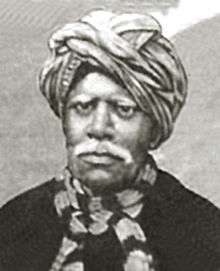Kandukuri Veeresalingam
| Kandukuri Veeresalingam Pantulu | |
|---|---|
 | |
| Born |
April 16, 1848 Rajahmundry, Andhra Pradesh, India |
| Died |
May 27, 1919 (aged 71) Madras [1] |
| Nationality | Indian |
| Occupation | Social reformer, writer |
| Spouse(s) | Rajyalakshmi |
Rao Bahadur Kandukuri Veeresalingam Pantulu (Telugu: కందుకూరి వీరేశలింగం పంతులు) (16 April 1848 – 27 May 1919) was a social reformer, writer of Andhra Pradesh. He was one of the early social reformers who encouraged women education, remarriage of widows which was not supported by the society during his time and fought against dowry system. He also started a school in Dowlaiswaram in 1874.[2] His novel Rajasekhara Charitramu is considered to be the first novel in Telugu literature.[3] His autobiography is named Sweeya Charitramu.
Early life
Veeresalingam was born in an orthodox Brahmin family in Rajahmundry, Andhra Pradesh to Subbarayudu, and Poornamma. When he was six months old, he suffered from smallpox, a dangerous disease during that time. But somehow he survived. He lost his father when he was four years old. He was adopted by his paternal uncle Venkataratnam. After studying in an Indian street school, he was later sent to English medium school where his talents were recognized. His good nature and studiousness earned him the best student award in his school. He completed his matriculation in 1869 and got his first job as a teacher in Korangi village.[2]
Literature
He had a good command over Telugu, English, and Sanskrit. He considered the literature as a weapon to fight against social evils. So his writings also reflected the same. He wrote many plays criticizing the attitude of Brahmin priests such as Prahlada (1885), Satya Harischandra (1886) etc.[2]
Brahmo Samaj
Veeresaligam was inspired by the principles Brahmo Samaj leaders like Raja Rammohan Roy, Ishwar Chandra Vidyasagar, Keshab Chandrasen. He started his own Brahmo mandir in Rajahmundry in 1887.[2]
Social Reformer
Welfare of women
Pantulu's one of the greatest reforms are to promote women education, which was considered to be sin in those days. In 1876, he started a journal called Viveka Vardhini in which he used to write articles about the problems of women. The magazine was initially printed at Chennai, but when it gained popularity, he established his own press at Rajahmundry.
Remarriage of widows was not appreciated in the society during those days. He opposed this by arguing that it was not prohibited by Dharma Sastra. He used to quote verses from scriptures to prove his point. His opponents used organize special meetings and debates to counter his arguments. They also resorted to physical violence against him as they failed to prove their point. Undeterred Veeresalingam started a Remarriage Association and sent his students to all over Andhra Pradesh to find young men willing to marry widows. He arranged the first widow remarriage on December 11. 1881. For his reformist activities, Kandukuri gained attention all over the globe. The Government, in appreciation of his work, conferred on him the title of Rao Bahadur in 1893. Later he established a Widow Home.[3]
Personal life
Veeresalingam was married to Bapamma Rajyalakshmi in 1861. At the time of marriage, he was 13 years old, and his wife was 8.[2]
Politics
Kandukuri Veeresalingam served as one of the members of the first Indian National Congress (INC) meeting in 1885.[2]
Death
He died on May 27. 1919 at the age of 71. His statue has been established on Beach Road in Vishakhapatnam.[2]
Notes
| Wikimedia Commons has media related to Kandukuri Veeresalingam. |
- ↑ Arnab, Sengupta. "Kandukuri Veeresalingam Pantulu (Andhra Social Reformer)". ImportantIndia.com. Important India. Retrieved 20 June 2016.
- 1 2 3 4 5 6 7 Editor, ILoveIndia. "Kandukuri Veeresasilngam Biography". iloveindia.com. iloveindia. Retrieved 20 June 2016.
- 1 2 Vepachedu, Srinivasa Rao. "Kandukuri Veeresalingam, Father of Andhra Rensissance". Vepachedu.org. Vepachedu Srinivasa Rao. Retrieved 20 June 2016.